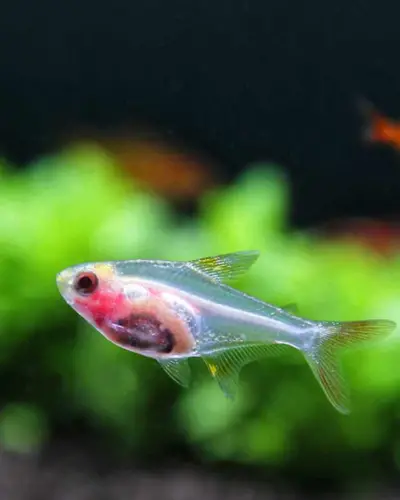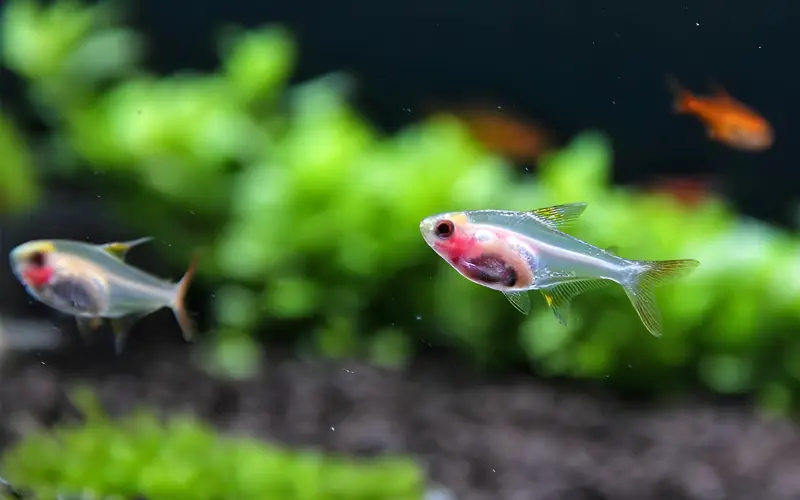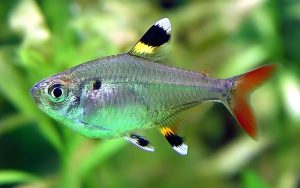Are X Ray Fish Real? X Ray Fish, also known as Pristella maxillaris, is a fascinating aquatic creature that has captured the curiosity of many. With its transparent body and unique appearance, it is no wonder that people question whether this extraordinary fish is real or merely a myth.
In this article, we will explore the facts and myths surrounding the golden pristella tetra Fish, its distinctive characteristics, behavior, and origins.
Despite its seemingly mythical appearance, the X-ray fish is a real species found in freshwater habitats in South America. Its transparent body allows for a clear view of its internal organs, earning it the nickname “X-ray fish.”

While some may believe that this fish possesses supernatural abilities or powers, the reality of its existence is grounded in the fascinating world of biology and natural adaptation.
Join us as we uncover the truths and dispel the myths surrounding the mysterious X Ray Fish.
Table of Contents
ToggleAre X Ray Fish Real? Amazing Facts About the X-Ray Tetra
Is There an X-ray Fish? The X-ray fish, also known as the golden pristella, is a small species of tetra fish native to the Amazon basin; during the rainy season that the x ray is commonly found in coastal waters, flooded marshlands, streams, and tributaries.

This predatory fish is known for its distinctive feature of having transparent skin that allows you to see its organs and skeleton. The X-ray fish is also known for its schooling behavior and can often be found in large groups in the wild.
It is an omnivorous species, feeding on small fish, plant and algal material, and even worms. The X-ray fish reaches sexual maturity within a few months and can lay up to 300-400 eggs at a time. The Latin name of the X-ray fish is Pristella tetra.
But Why that Unusual Translucent Skin?
The transparency of X-ray fish, like the Pristella maxillaris, is likely an adaptation for camouflage. Their translucent skin makes them hard to see for predators, especially in environments with shimmering water and dense vegetation. It’s like a natural invisibility cloak!
One of the critical features of the X-ray fish is its bony internal structure, particularly the Weberian apparatus, which allows it to detect sound waves in the water.
This adaptation helps the X-ray fish evade larger predatory fish and detect potential environmental threats. The X-ray fish develop their characteristic adult markings within a few days of hatching, and their dorsal and anal fins begin to stand out prominently.
Where Do X Ray Fish Live?
Pristella maxillaris or X-ray tetras are native to the coastal regions of the Amazon basin in South America, particularly in Brazil, Guyana, and Venezuela. They are unique among tetras because they can tolerate fresh and brackish water,
a mixture of fresh and saltwater. This allows them to thrive in a wider range of habitats.
- During the dry season, freshwater streams and tributaries are their preferred habitat. The water in these areas is typically straightforward and free of debris.
- Flooded marshlands: X-ray fish migrate to flooded marshlands during the rainy season. This provides them with access to more food and breeding grounds. The water in these areas is often softer and more acidic than in the streams.
What Does an X-Ray Fish Look Like?
One distinctive feature of the X-ray Tetra is its translucent skin, which allows you to see its internal organs, giving it the appearance of an X-ray.
This silvery-yellow fish is popular in aquariums due to its striking appearance and peaceful nature. The X-Ray Tetra is a schooling fish that thrives in groups and is often found in tributaries during the dry season.
Female X-ray tetras are known to lay their eggs on plants and other surfaces within the fish tank, where they hatch 24 hours later or newborn fry-free swim within a few days.
This species, also known as the Weberian Apparatus, has a special sensory system that enhances its sense of hearing and picks up sound waves. The X-ray tetra is closely related to the Pristella Tetra and the Water Goldfinch, both of which are tropical fish found in the Amazon.
Can You Keep an X-ray Fish in an Aquarium?
X-ray fish, also known as Pristella maxillaris or X-ray tetras, are popular aquarium pets due to their peaceful temperament, small size, and attractive translucent bodies.
Here’s what you need to know to keep X-ray fish happy and healthy in your tank:
- Tank size: X-ray tetras are schooling fish, so they do best in groups of 6 or more. A 10-gallon tank is the minimum recommended size for a small school, but a 20-gallon tank or larger would be even better.
- Water parameters: X-ray tetras prefer slightly acidic water (pH 6.0-7.5) with a temperature range of 75-82°F (24-28°C). They do well in soft to moderately hard water.
- Tank mates: X-ray tetras are peaceful freshwater fish kept in aquariums with other peaceful fish of similar size. Avoid keeping them with large or aggressive fish that could prey on them. Good tank mates include other tetras, Rasboras, Corydoras catfish, and dwarf Gouramis.
- Diet: X-ray tetras are omnivores and eat a variety of foods, including flakes, pellets, brine shrimp, daphnia, and bloodworms. They thrive on a varied diet of plant—and meat-based foods.
- Tank decoration: Provide your X-ray tetras with plenty of hiding places, such as live plants or driftwood. They also appreciate a tank with some floating plants to help diffuse the light.
With proper care, X-ray fish can live for 5-8 years in an aquarium. A suitable environment is essential to ensure their health and longevity in captivity.
This includes maintaining clean and well-oxygenated water, ensuring a balanced diet, and monitoring water quality regularly. It is also important to avoid overcrowding in the aquarium and to provide appropriate hiding places for them to feel secure.
Regular water changes and filtration maintenance are vital to keeping X-ray fish healthy and thriving in a home aquarium.
Commonly Asked Questions about Pristella Maxillaris Tetra Fish (FAQs)
Are X-ray fish aggressive?
No, X-ray fish are peaceful community fish. They are too small to harm others and do their best in schools with their kind.
Do X-ray fish have bones?
Yes, X-ray fish have bones! Through their transparent skin, you can see their spine and even a particular bone for hearing called the Weberian apparatus.
Why are X-ray fish transparent?
Why are X-ray fish see-through? X-ray fish aren’t truly transparent; they have clear skin and muscles, allowing you to see their internal organs. This is due to a lack of pigmentation and thin scales. This adaptation allows them to blend into their surroundings and avoid predators in the murky waters they inhabit.
What are the predators of X-ray fish?
Due to their small size, X-ray fish are preyed upon by slightly larger fish, amphibians like frogs, and even birds and snakes hunting near the water surface.
Conclusion
In conclusion, marine life’s mysterious and captivating world never ceases to amaze us. From vibrant coral reefs to the deep, dark abyss, countless wonders await discovery. Throughout this article, we have explored some of the fascinating creatures that inhabit our oceans, from the elusive giant squid to the mesmerizing bioluminescent jellyfish. However, amidst all these extraordinary beings, one question often arises: Are X-ray fish real?
Are x ray fish real? Well, the answer is both yes and no. While no species are specifically known as “golden pristella tetra,” there are indeed fish with translucent bodies that allow us to see their intricate skeletal structures. These remarkable creatures, such as the glass catfish and ghost knife fish, give us a glimpse into the hidden world beneath the water’s surface.
So, the next time you gaze into an aquarium or explore the ocean’s depths, remember the possibility of encountering these ethereal beings. And who knows, maybe one day you’ll catch a glimpse of a real-life X-ray fish, reminding us again of the astonishing diversity within our vast oceans.
Recommended posts
- Pristella Tetra Male Vs Female (How to Identify the Gender!)
- 9 Fascinating X-Ray Tetra Facts and Information (Must Read)
- Pristella Tetra Size: 3 Factors That Influence Their Growth!
- Where Do X-Ray Fish Live in the World (Habitat Diversity)
- X Ray Tetra Lifespan 101: Secret Tips to Prolong their Life!





